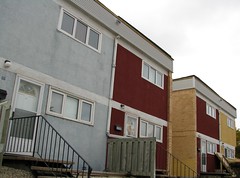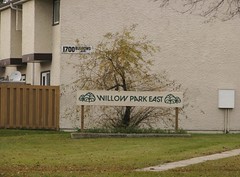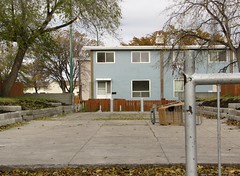Architect: Ian MacLellan (CMHC)
Contractor: Imperial Construction Ltd.
Opened: June 26, 1964
"Slum Housing" ca 1969 (Winnipeg Tribune Archives)
In the 1960s the Canada Mortgage and Housing Corporation (CMHC), the federal government's housing agency, turned its attention to urban redevelopment through the construction of multi-family housing complexes.
The timing was right for Winnipeg. The flight to the suburbs in the decade following World War II saw many middle and working-class core area neighbourhoods fall into disrepair. Many in and around the downtown were bulldozed in favour of large development projects like the post office, Convention Centre, Holiday Towers and various high rise apartments.
In Summer 1960 the city agreed to split a large section of unserviced land in the Burrows - Keewatin area into three sections: 16 acres for seniors housing; 10 acres for public housing; and 36 acres for private development. The area included room for schools, shops and other services.
July 18, 1963, Winnipeg Free Press
The public housing portion, initially called the Burrows - Keewatin Development, was to cost $8.4 million, which also covered servicing the land and the "Jarvis clearance" (see below). The federal government / CMHC picked up 75% of the tab under the National Housing Act while the province and city split the other 25%. The province also agreed to create a housing authority to manage the complex once completed.
The project was a larger version of a CMHC project recently completed in Regina designed by Ian MacLellan. It was to have 75 one-bedroom houses with an approximate rent of $61 per month; 144 two-bedroom houses for $73 per month: 413 three-bedroom houses for $78; 135 four-bedroom houses for $82 and 150 two-bedroom apartments for $74 per month. (Source: March 8, 1961, Winnipeg Free Press, p.1)
Below: January 15, 1963, Winnipeg Free Press, p. 1
The contract for Phase I of the project, consisting if 18 buildings that would house 165 families, was awarded in December 1962 and in April 1963 the city set about finding families to fill them.
They set their sights on a stretch of Jarvis Avenue near Dufferin that newspaper reports of the day referred to as the worst slum in the city. In April 1963 the city approved $1.5 million towards a $3 million plan that would see the slum cleared. The 126 displaced families would be moved to new houses in phase I of Gilbert Park.
The cost-sharing formula was to be the same as the rest of the Gilbert Park's funding but there was a catch. Clearing slums would not be covered by the feds unless there was a public housing project built on the same land. The city, which had to redevelop the site anyway, finalized plans in March 1963 for what would become the Lord Selkirk Housing Project that would begin as soon as the slum was cleared.
A program called Operation '63 was put in place calling for donations of furniture and other household items for the new homes as most of the families' existing furniture was deemed in too poor a condition to move. Many religious and charitable organizations as well as business owners donated.
September 19, 1963, Winnipeg Free Press
Not everyone was pleased with the new development. Some expressed concerns that moving slum dwellers to new housing would just create a new slum. A group of Burrows Avenue area residents hired a law firm to go after the city for what it considered illegally changing the zoning on the land.
To address some of these concerns, applicants had to apply for residence in the new development and a committee of five people examined the application, including checking into the family's background, to ensure that they were worthy of the new digs.
The first families moved in by Christmas 1963.
June 27, 1964, Winnipeg Free Press
On June 26, 1964 the official opening of the Burrows - Keewatin Development took place. At the time it consisted of 17 buildings with a total of 58 two-bedroom units, 90 three-bedroom units, 13 four-bedroom units and 4 five-bedroom units.
Representing the feds was Canada's Postmaster-General John R. Nicholson, (oddly, that was the position responsible for CMHC operations.) Mayor Steven Juba and Robert Smellie, the province's Urban Affairs Minister, were also on-hand. Nicholson said: "We do not want to see Canadian children raised in near slum or blighted areas....our goal is nothing less than a decent standard of housing for all Canadians." (June 27, 1964, Winnipeg Free Press, p.1.)
January 17, 1964, Winnipeg Free Press
An early problem for the residents was what some called the "fishbowl effect." As Winnipeg's first low-income public housing project, it was studied at universities and discussed in great detail in the media. When it opened, residents were under the microscope of those eager to prove or disprove theories about how the former "slum-dwellers of Jarvis Avenue" would act in their new home.
Some, including Councillor Joe Zuken, felt that "...a new name might change the image", (June 10, 1964 Winnipeg Free Press, p 16.) Officials considered Shaugnessy Park (for the nearby school) and John Blumberg Park (after a former cit alderman) but over time tthen the new name idea waned.
It was the local tenants association that requested "Gilbert Park", after Gilbert Street that ran through it and the name of the central courtyard green space.
There were some growing pains. A Winnipeg Free Press visited the development a year later and noted that there were difficulties integrating with the surrounding neighbourhoods. A chief complaint from residents was that there were no stores and few basic services available in the immediate area and the city only provided a very basic transit service.
Additional 90 units were built in 1968.
Slum house with Lord Selkirk Park in background
ca 1966 Winnipeg Tribune Photo Archive
As mentioned above, the Lord Selkirk Park development, was approved in 1963 and got underway in 1966. At over 300 units, it was twice the size of the original Gilbert Park development.
In 1965 there was more housing development in the Burrows-Keewatin Development area when construction began on the Willow Park Housing Co-op , (the 'Lego houses' off Burrows Avenue). It was one of the first, some newspaper accounts refer to it as THE first, public housing co-op project in Canada. The 11 acre, 200 unit, $1.5 m project proved successful and a second phase, Willow Park East, followed in 1970 and 1973.
"When Winnipeg's mid-twentieth century history is written it will not be the new city hall or Centennial Centre that will mark the top achievement in municipal progress. Instead, top achievement award - if an Oscar is ever awarded for outstanding municipal achievements - will go to Winnipeg's housing and urban renewal schemes, a giant face-lifting plan which aims to .convert the city's slum areas into healthful, productive communities where thousands of citizens will regain what they treasure most - their self-respect."
(Llew McKenzie, Winnipeg Free Press reporter, April 19, 1966, "Progress Supplement", p 5.)
Related: Gilbert Park Manitoba Housing It’s getting great: Government investment in Gilbert Park and Lord Selkirk Park CCPA
History of CMHC Canada Mortgage and Housing Corporation













I’m just reading the book “Property Wrongs” by Doug Smith and came across this post while googling for more photos. Very interesting!
ReplyDeleteI made a comment a year or 2 ago but seems no one monitors this page, as a mistake is still there. The 2nd photo from the top, the black-and-white photo, is **1959** not 1969. It's from the Winnipeg Tribune dated Oct 17, 1959.
ReplyDelete